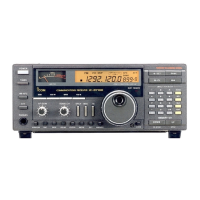Pin 7
ol
lC2b
supplies a tuned voltage to BPF4.
Q9
and
010.
switch
Ihe
gain and ortset vollage
ol
IC2b ON or OFF
and convert the varlalions
of
2 PLL loek voltages lnto a
continuous tuned voltage.
Tabla 2 shows Ihe retatlon between receive frequency
and 1st IF Irequency.
Pin 1
ol
IC3b supplies a luned vollage to Ihe luned neten
clrcuil
on
Ihe
TRAP UNIT.
011 swilches Ihe offset voltage
ol
IC3b ON or OFF and
converts the variations
of
2
Pll
loek voltages into a
continuous luned voltage.
RECEIVE FREOUENCY [MHz]
1
et
IF FREOUENCY [MHz]
25-
89
.9999
778
.7 (FI1)
90-
249
.9999
778
.7
(Fll)
250-
511 .9999
778
.7 (FI1)
512
-1024.9999
266
.7 (FI2)
Tabl.2
Fig. 4 shows the
character
isties
of
the 1st IF filter.
3·1·6
1st
MIXER CIRCUIT (MIX1 UNIT)
'lST
IF
FILTER CHARACTERISTICS
I
I
I
I
I
I
I
I
I
I
'0.
Frequency
Fig. 4
I,
-21
.4
MHz
c
o
äi
"
;-
_co
->
<o!!
The
1st mixer circuit converts Ihe received
signailo
a
IIxed
Irequency
ol
the 1st IF signal
wilh
a PLL output
frequency. By changing the PLL frequency, only the
desired Irequency will pass Ihrough the
FIL1
UNIT or
FIL2 UNIT
al
the next stage
of
Ihe
1st mixer.
A 778
.7-1291
.7 MHz (0 dBm)
lst
LO signal is applied
la
a bandpass
111Ier
(strlp line. L78.
Cl34
. C59. C77.
C53-
C55) on tne
MIXl
UNIT to suppress unwanted signals
Ihrough
Pl
from Ihe PLL UNIT. The filtered slgnal is
amplified at Ihe 1st LO amplifiers
(05.
06). The 1
st
LO
amplifiers
(05,
06)
employ wide frequency band amplifiers
wlth approximalely 10
dB
gain and amplify the 1st LO
signaI
la
approxlmalely 10 dBm.
The
25.0000-1024.9999
MHz slgnals
are
mixed
al
ICS
with
Ihe
1st LO signal
la
produce a 266.7 or 778.7 MHz
1st IF signal.
ICS
employs a DBM (Double Balanced
Mixer).
Tabla 1 shows Ihe relation between receive frequency and
1sI LO frequency.
(1) FIL1
CIRCUIT
(25-511.9999
MHz)
The 778.7
MHz
1st IF signal
is
applied to an inductlve \
bandpass
li
lter
(Fll)
to suppress out-of-band signais.
Fll
sets
Ihe
center frequency at 778.7 MHz and covers a
5
MHz bandwldlh. The fillered signal is applied to a noten
filter (L51. C79)
la
suppress
Ihe
image interference signal
(757.3
MHz).
RECEIVE FREOUENCY [MHz]
1
st
lO
FREOUENCY [MHz]
25
-
89
.9999
803
.7
-
868
.6999
90-
249
.9999
868
.7
-1028
.6999
2
50
- 511
.9999
1
02
8.7- 1
290
.6
999
512-1024
.9999
778.7-1291.6999
roble 1
3·1·7 1
st
IF
CIRCUIT
(RF, FIL1 AND FIL2 UNITS)
(2)
FIL2
CIRCUIT
(512-1024.9999
MHz)
The 266.7
MHz 1st IF slgnal Is applied
la
a helical
lilter
(L46. L47) to suppress out-of-band signa
ls
Ihrough
a series resonant circu
it
(L73. C66). The helical filler
sets the
center
frequency at 266.7 MHz and covers a
5
MHz
bandw
ldlh
. The filtered slgnal passes Ihrough a
nolch
fliler (L67. L68.
CS8)
la
suppress
Ihe
image inler·
ference slgnal (245.3
MHz) and is then applied to series
resonant clrcults (L74. C90). The series resonant circuits
atlenuate out-ot-band signais.
The 1st IF signal (226.7
or
778.7 MHz) Is applied to a
1
st
IF
amp
lilier
(08)
providing approxlmalely 10 dB gain
over
a wideband frequency range. The 1st IF amplifier
emp
loys a feedback circuit (L43. C72. R56)
la
oblain
stabie gain in
Ihe
wlde Irequency range. The 2nd IF
slgnal is applied
10
t\Yo separate filters depending on
Ihe
receive frequency.
The 266.7
or
778.7 MHz 1st IF signal Is applied
la
a low-
pass filter (str
ip
line.
C139-C141)
la
suppress tne high
harmonie components
on
t
he
RF UNIT.
3-4

